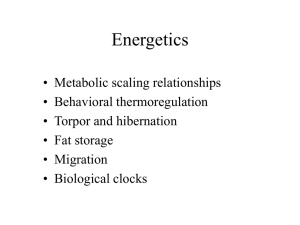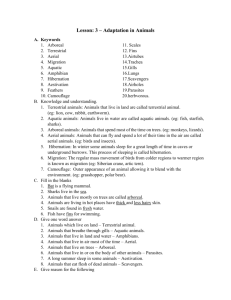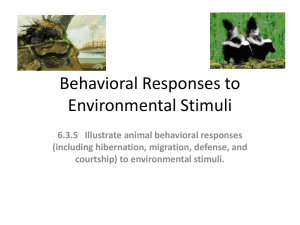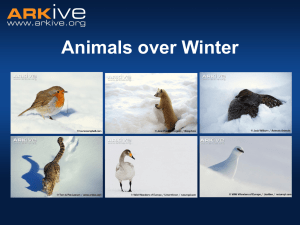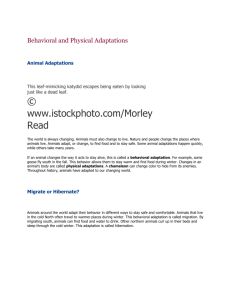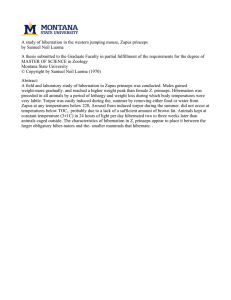How to tell torpor from hibernation
advertisement
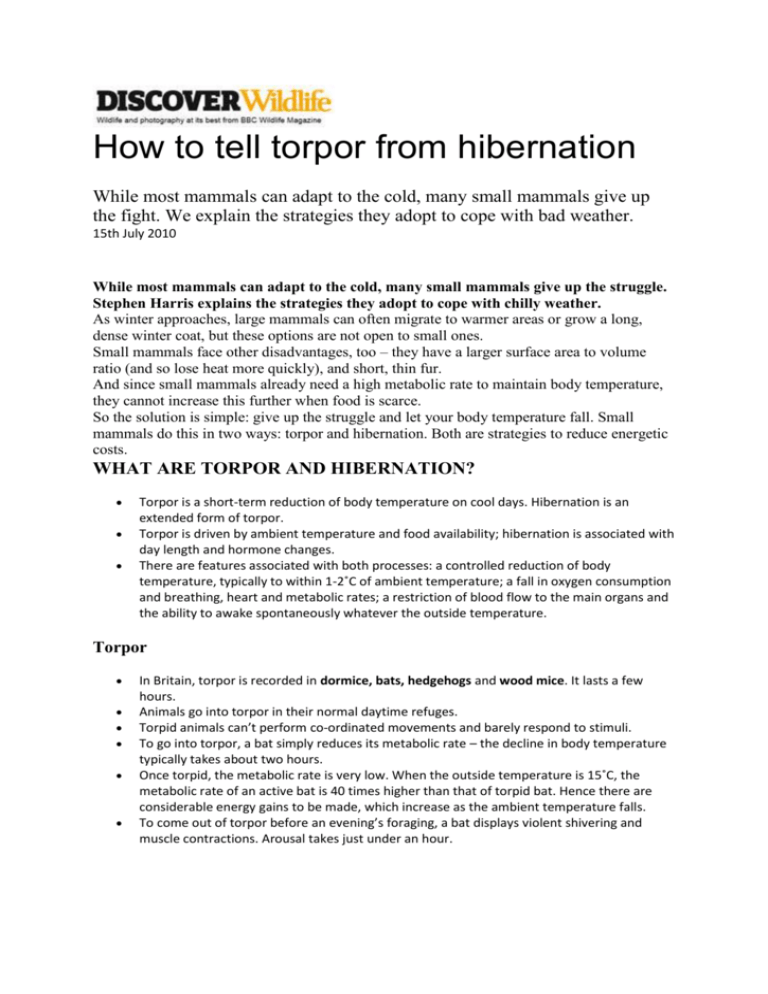
How to tell torpor from hibernation While most mammals can adapt to the cold, many small mammals give up the fight. We explain the strategies they adopt to cope with bad weather. 15th July 2010 While most mammals can adapt to the cold, many small mammals give up the struggle. Stephen Harris explains the strategies they adopt to cope with chilly weather. As winter approaches, large mammals can often migrate to warmer areas or grow a long, dense winter coat, but these options are not open to small ones. Small mammals face other disadvantages, too – they have a larger surface area to volume ratio (and so lose heat more quickly), and short, thin fur. And since small mammals already need a high metabolic rate to maintain body temperature, they cannot increase this further when food is scarce. So the solution is simple: give up the struggle and let your body temperature fall. Small mammals do this in two ways: torpor and hibernation. Both are strategies to reduce energetic costs. WHAT ARE TORPOR AND HIBERNATION? Torpor is a short-term reduction of body temperature on cool days. Hibernation is an extended form of torpor. Torpor is driven by ambient temperature and food availability; hibernation is associated with day length and hormone changes. There are features associated with both processes: a controlled reduction of body temperature, typically to within 1-2˚C of ambient temperature; a fall in oxygen consumption and breathing, heart and metabolic rates; a restriction of blood flow to the main organs and the ability to awake spontaneously whatever the outside temperature. Torpor In Britain, torpor is recorded in dormice, bats, hedgehogs and wood mice. It lasts a few hours. Animals go into torpor in their normal daytime refuges. Torpid animals can’t perform co-ordinated movements and barely respond to stimuli. To go into torpor, a bat simply reduces its metabolic rate – the decline in body temperature typically takes about two hours. Once torpid, the metabolic rate is very low. When the outside temperature is 15˚C, the metabolic rate of an active bat is 40 times higher than that of torpid bat. Hence there are considerable energy gains to be made, which increase as the ambient temperature falls. To come out of torpor before an evening’s foraging, a bat displays violent shivering and muscle contractions. Arousal takes just under an hour. Hibernation Hibernators generally select special hibernacula, but hedgehogs may use summer nests. Bats often have very specific temperature and airflow requirements. Common dormice hibernate at ground level in woven nests partly covered by leaf litter or moss or in hollow trees. Edible dormice have been recorded under tree roots and beneath floorboards in outbuildings. Body temperatures drop a lot lower than in torpor, with metabolic rates falling to between 1 and 2 per cent of the active animal. The heart rate of an active hedgehog is 200 to 280 beats per minute, but only 5bpm in hibernation. The body temperature of a hibernating hedgehog is around 4˚C. If the ambient temperature drops below zero, the metabolic rate is increased to prevent the animal from freezing. This is still less expensive than the energy costs of complete arousal. Do mammals wake up during hibernation? Yes – though it’s more extended than torpor, hibernation is not continuous. Waking up from hibernation takes a few hours. Hedgehogs do this on average every 7 to 11 days and British bats about every 20 days. Hedgehogs may be seen in winter moving to another nest before resuming hibernation. When bats emerge from hibernation, they fly around in or emerge from their caves. They may drink as they lose a lot of water during hibernation. It must be important for mammals to wake up periodically, since bouts of arousal consume 80 per cent of energy reserves expended during hibernation. Recent research suggests that mammals are vulnerable to parasites during hibernation and so wake periodically to boost their immune systems. 10 ANIMALS THAT HIBERNATE http://www.conservationinstitute.org/10-animals-that-hibernate/ Animals have the amazing ability to survive even the harshest of circumstances. Some animals hibernate (go into a deep sleep) so they can survive throughout the cold season when the weather is freezing and the food is scarce. Hibernation truly is a clever survival mechanism. Here is a list of 10 animals that hibernate. 10. Wood Frogs Wood frog (Michael Zahniser / Wikimedia commons) If you saw a frozen frog that had ice crystals on it, that wasn’t breathing and didn’t have a heartbeat, you would probably think it was dead. If it was a wood frog, it would most likely be in hibernation. Wood frogs hibernate inside logs or burrows or under rocks or leaf piles. During the cold of winter, when in hibernation, they actually stop breathing, their heart stops and ice crystals form in their blood. When the weather warms, they defrost, and their lungs and heart go back into action. Pretty amazing! 9. Deer Mice Deer mouse (NPS photo by Sally King) Deer mice have short lives and short torpor (light hibernation) periods. During cold weather, they torpor from morning to late afternoon bundled up with their buddies and then spend the night searching for food. Between their daily torpor and the shared heat from snuggling up together, deer mice are able to save valuable amounts of energy. 8. Common Poorwills Common Poorwill (Louis Agassiz Fuertes) Common poorwills are the only species of bird that go into true hibernation. A handful of other bird species go into torpor (light hibernation). Common poorwills hibernate when the temperatures get really cold, really hot or when food is scare. When necessary, they can even hibernate while incubating their eggs. That’s one way to pass the time, while waiting for the chicks to hatch! 7. Ground Squirrels Ground squirrel (U.S. Fish and Wildlife Service) Most types of ground squirrels hibernate and some do so for nine months a year. They also torpor (light hibernation) during other times of the year for a few days at a time. Ground squirrels have great hibernation spaces. They dig elaborate underground tunnels with different rooms for food storage, sleep and elimination (yes, they have bathrooms). An interesting fact about ground squirrels is that they go into hibernation as a response to a change in their blood. Scientists have been able to get an active ground squirrel to go into hibernation by injecting it with blood from a hibernating squirrel. 6. Skunks Striped skunk (Wikimedia Commons) During the cold winter months, skunks get comfy in their dens and torpor (light hibernation) in the company of their close family. During their few month torpor, they occasionally wake up and come out to scrounge up something to eat. 5. Hamsters Syrian hamster filling his cheek pouches (Peter Maas / Wikimedia Commons) Many a loving pet owner have cried out in dismay when they found their hamsters dead, only to learn they were actually in torpor (a light hibernation). Once those hamsters were rustled about, they probably awoke pretty grouchy and scared. Hamsters hate being awoken from this state. In addition, the sudden disturbance can cause a heart attack, literally scaring them to death. Hamsters torpor for a few days to a week at one time when the weather is cold. They will only torpor if there is plenty of food nearby so they can snack during brief waking bouts. 4. Prairie Dogs Prairie dogs (Wikimedia Commons) Prairie dogs aren’t really dogs; they’re actually rodents, but they do bark kind of like dogs. They also are really good at surviving cold weather. Depending on the species of prairie dog and the area it lives in, it either hibernates or goes into torpor. White-tailed prairie dogs hibernate through the winter. Black-tailed prairie dogs go into torpor for a few days at a time, and only hibernate on rare occasions during extreme cold weather conditions. 3. Bats White-winged vampire bat (Wikimedia Commons) Bats are interesting for so many reasons. They’re the only true flying mammals, they navigate using echolocation, have been around since the dinosaur days and they hibernate. Bats go into a true hibernation, meaning they are in such a deep sleep that they may appear to be dead. During hibernation, a bat’s heart rate drops from 400 to 25 beats per minute, and its breathing slows so much that it might not take a breath for up to an hour. Bats hibernate in the cavities of large trees, caves, old mine shafts, old wells, and even in people’s attics. Depending on the species of bat, it either hibernates alone or in a group. 2. Hedgehogs Hedgehog (Lars Karlsson / Wikimedia Commons) Hedgehogs hibernate anywhere from a few weeks to six months, depending on the weather. During hibernation, their heart rate drops almost 90 percent. They wake briefly if their body temperatures drop too low and let their waking heart rate warm their bodies up before going back into hibernation. Hedgehogs also go into estivation when the weather is really hot. Estivation is like hibernation, except for it takes place during hot weather, instead of cold weather. When the weather is scorching hot, who can blame a hedgehog for passing out for a while? 1. Bears Black bear (Jon Sullivan / Wikimedia Commons) When people think of animals that hibernate, bears are often the first animals they think about. Ironically, bears aren’t true hibernators. They are more like light hibernators. Instead of hibernating, bears go into what is called a torpor. The main difference between a torpor and a hibernation is that during a torpor the animal is easily awoken. So tread lightly near that bear’s den; it will wake up. Bears go into a torpor during the winter months only if they live in cold areas. During their torpor, they don’t eat or drink for about 6 months on average and they rarely urinate or defecate. In addition, female bears give birth to and nurse their young during torpor. Aren’t you women jealous? This list of animals that hibernate isn’t an all-inclusive list; there are many more animals that hibernate or torpor, but we have highlighted some of the most interesting hibernators.
